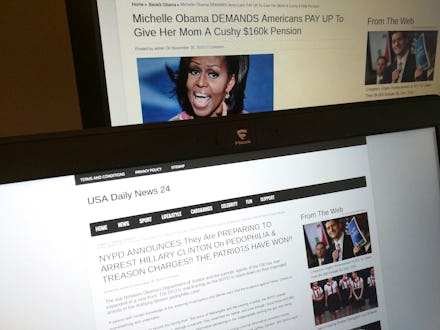Fake News Sites: These are the websites spreading fake news and conspiracy theories

Fake news sites are making it difficult for many people to distinguish between reality and fantasy. And the responses to these fake stories are starting to get worrisome.
In one glaring example, a man from North Carolina armed himself with an assault rifle and fired off at least one shot in Comic Ping Pong pizzeria in Washington, D.C., after he was influenced by a fake news story that alleged the restaurant had operated as a Hillary Clinton-run underage sex ring.
The implications of these fake sites are clearly concerning. So who is spreading the fake news? Here's a few examples of known fake sites, and tips on spotting the difference between fake and real news.
How to spot fake news sites
Fake News Watch describes fake news as sites that "attempt to play on gullible people who do not check sources and will just pass the news on as if it were really true." They are different from satire sites like the Onion, which use satire to poke fun at real world events using humor. On the contrary, fake news (or hoax) sites are more about trying to trick people into believing the fake stories in an effort to gain clicks and turn a profit.
One way to tell if a news article is fake? Check out the URL suffix. Oftentimes fake sites will add extra letters after ".com" or will use less popular suffixes like ".lo," and will purposely copy a real site's URL in order to sound legitimate.
Many who clicked a story this year describing how President Barack Obama was issuing an executive order banning the pledge of allegiance in schools likely thought that they were reading a story from ABC News. In reality, the site was fake news outlet abcnews.com.co.
Another way to spot fake news is to focus in on the linked information in the story itself (yes, beyond reading just the headline). Most reliable news media thoroughly source their stories. If a news story doesn't contain many linked sources, you can count on it being fake (or at the very least, unreliable) until you see it sourced elsewhere.
Examples of fake news headlines
Many fake news stories come from sites that have reliable sounding names. An example of this included a site with the domain name DrugdeReport.com.co, which is separate from the real Drudge Report. While the site has since been taken down, it churned out a number of fake news articles, including "House Republicans Proposing 'Dress Code' for First Daughters," and "Gay Coalition Seeks to Replace FingerPrinting with 'SphincterPrinting.'"
The Christian Times Newspaper is yet another example of a fake news site trying to fool readers. The site is notorious spreader of fake news, and is likely trying to catch readers who are seeking information from the more legitimate Christian Times. In one instance, the Christian Times Newspaper published a story alleging that fraudulent Clinton votes had been found in a warehouse in Ohio.
The site AmericanNews.com has more than 5 million Facebook followers currently, but unfortunately their news is just not accurate, including this article stating that Obama told Pearl Harbor vets to "get over it."
The role of social media
Social media sites have an undeniable hand in the dissemination of fake news. Some have started to blame Facebook for allowing such information to spread. For his own part, CEO Mark Zuckerberg has stated that he doesn't believe fake news on Facebook played a big role in things like this year's election, calling the idea "crazy."
But that doesn't mean sites aren't attempting to combat the problem. Facebook has announced intentions to ban such sites from advertising on its platform and Google says it will refrain from advertising on those sites.
Most of the problem with fake news being shared on social media, however, is from users themselves who share stories that confirm their biases. In the end, it seems people will see what they want to see and share what they want to share — facts be damned.